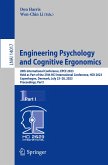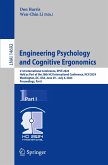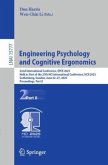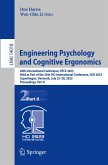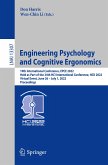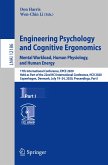Engineering Psychology and Cognitive Ergonomics
21st International Conference, EPCE 2024, Held as Part of the 26th HCI International Conference, HCII 2024, Washington, DC, USA, June 29 - July 4, 2024, Proceedings, Part II
Herausgegeben:Harris, Don; Li, Wen-Chin
Engineering Psychology and Cognitive Ergonomics
21st International Conference, EPCE 2024, Held as Part of the 26th HCI International Conference, HCII 2024, Washington, DC, USA, June 29 - July 4, 2024, Proceedings, Part II
Herausgegeben:Harris, Don; Li, Wen-Chin
- Broschiertes Buch
- Merkliste
- Auf die Merkliste
- Bewerten Bewerten
- Teilen
- Produkt teilen
- Produkterinnerung
- Produkterinnerung
This two-volume set LNAI 14692-14693 constitutes the thoroughly refereed proceedings of the 21st International Conference on Engineering Psychology and Cognitive Ergonomics, EPCE 2024, held as part of HCI International 2024,held in Washington, DC, USA, during June 29 - July 4, 2024.
The total of 1271 papers and 309 posters included in the HCII 2024 proceedings was carefully reviewed and selected from 5108 submissions.
The papers included in the HCII-EPCE two-volume set were organized in topical sections as follows:
Part I: Cognitive Processes and Performance in High-Stress…mehr
Andere Kunden interessierten sich auch für
![Engineering Psychology and Cognitive Ergonomics Engineering Psychology and Cognitive Ergonomics]() Engineering Psychology and Cognitive Ergonomics76,99 €
Engineering Psychology and Cognitive Ergonomics76,99 €![Engineering Psychology and Cognitive Ergonomics Engineering Psychology and Cognitive Ergonomics]() Engineering Psychology and Cognitive Ergonomics57,99 €
Engineering Psychology and Cognitive Ergonomics57,99 €![Engineering Psychology and Cognitive Ergonomics Engineering Psychology and Cognitive Ergonomics]() Engineering Psychology and Cognitive Ergonomics50,99 €
Engineering Psychology and Cognitive Ergonomics50,99 €![Engineering Psychology and Cognitive Ergonomics Engineering Psychology and Cognitive Ergonomics]() Engineering Psychology and Cognitive Ergonomics62,99 €
Engineering Psychology and Cognitive Ergonomics62,99 €![Engineering Psychology and Cognitive Ergonomics Engineering Psychology and Cognitive Ergonomics]() Engineering Psychology and Cognitive Ergonomics83,99 €
Engineering Psychology and Cognitive Ergonomics83,99 €![Engineering Psychology and Cognitive Ergonomics Engineering Psychology and Cognitive Ergonomics]() Engineering Psychology and Cognitive Ergonomics68,99 €
Engineering Psychology and Cognitive Ergonomics68,99 €![Engineering Psychology and Cognitive Ergonomics. Mental Workload, Human Physiology, and Human Energy Engineering Psychology and Cognitive Ergonomics. Mental Workload, Human Physiology, and Human Energy]() Engineering Psychology and Cognitive Ergonomics. Mental Workload, Human Physiology, and Human Energy38,99 €
Engineering Psychology and Cognitive Ergonomics. Mental Workload, Human Physiology, and Human Energy38,99 €-
-
-
This two-volume set LNAI 14692-14693 constitutes the thoroughly refereed proceedings of the 21st International Conference on Engineering Psychology and Cognitive Ergonomics, EPCE 2024, held as part of HCI International 2024,held in Washington, DC, USA, during June 29 - July 4, 2024.
The total of 1271 papers and 309 posters included in the HCII 2024 proceedings was carefully reviewed and selected from 5108 submissions.
The papers included in the HCII-EPCE two-volume set were organized in topical sections as follows:
Part I: Cognitive Processes and Performance in High-Stress Environments; Decision-Making Support and Automation.
Part II: Engineering Psychology and User Experience; Human Factors in Aviation.
The total of 1271 papers and 309 posters included in the HCII 2024 proceedings was carefully reviewed and selected from 5108 submissions.
The papers included in the HCII-EPCE two-volume set were organized in topical sections as follows:
Part I: Cognitive Processes and Performance in High-Stress Environments; Decision-Making Support and Automation.
Part II: Engineering Psychology and User Experience; Human Factors in Aviation.
Produktdetails
- Produktdetails
- Lecture Notes in Computer Science 14693
- Verlag: Springer / Springer Nature Switzerland / Springer, Berlin
- Artikelnr. des Verlages: 978-3-031-60730-1
- Seitenzahl: 380
- Erscheinungstermin: 31. Mai 2024
- Englisch
- Abmessung: 235mm x 155mm x 21mm
- Gewicht: 569g
- ISBN-13: 9783031607301
- ISBN-10: 3031607309
- Artikelnr.: 70333912
- Herstellerkennzeichnung
- Springer-Verlag KG
- Sachsenplatz 4-6
- 1201 Wien, AT
- ProductSafety@springernature.com
- Lecture Notes in Computer Science 14693
- Verlag: Springer / Springer Nature Switzerland / Springer, Berlin
- Artikelnr. des Verlages: 978-3-031-60730-1
- Seitenzahl: 380
- Erscheinungstermin: 31. Mai 2024
- Englisch
- Abmessung: 235mm x 155mm x 21mm
- Gewicht: 569g
- ISBN-13: 9783031607301
- ISBN-10: 3031607309
- Artikelnr.: 70333912
- Herstellerkennzeichnung
- Springer-Verlag KG
- Sachsenplatz 4-6
- 1201 Wien, AT
- ProductSafety@springernature.com
Part 1: Engineering Psychology and User Experience: Evaluating User Experience for Intelligent Connected Vehicles: A Qualitative Study.- Lesson Learned: Design and Perception of Single Controller Operations Support Tools.- Gaze Distribution of an Observer While Imagining Wearing Clothing Portrayed in an Advertisement and Predicting the Impression on Others.- Feasibility Verification of Ergonomic Design Based on Alert Indicators.- Evaluation Method and Capability Improvement Research Based on Controller Capability Characteristics.- A Small Icon and its Effect on User Perception - How the Design of The Passenger Call Button Shapes Passengers Communication with Cabin Crew.- Behavioural Dynamics Towards Automation Based on Deconstructive Thinking of Sequences of Effects: 'As Is - To Be' Automation Effects Change Lifecycle.- Self-Organising Maps for Comparing Flying Performance Using Different Inceptors.- Trust Transfer in Autonomous Vehicles: The Role of Warm Brand Image Amid Automation Failure.- Ergonomic Analysis on the Effect of Background Music on Working Efficiency.- How to Present Paired Information on the HUD Interface: The Effects of Horizontal and Vertical Angles on Object Discrimination.- Part 2: Human Factors in Aviation: Seeing with Touch: The Effect of Full-Body Positional Haptic Feedback During Low-Visibility Aviation Ground Operations.- Research on Autonomy Control of Air Traffic Based on Accurate Awareness and Estimation of Wake Vortex.- An Analysis of Pilot's Eye Movements in Simulated Flight Scenarios.- Pre-shift State Assessment of Air Traffic Controllers Based on Improved Grey Correlation Theory.- Human Cognitive Reliability and R&D Efficiency: A Human Factor Study in Semiconductor Pilot Scale Production Line.- A Non-contact Vital Signs Retrieving Method for Aviation Safety Personnel Using TVF-EMD.- Comparative Analysis of Remote Tower Controllers and Traditional Physical Tower Controllers Based on Human Ergonomics in China.- Response to Acoustic Sounds and Synthesized Speech in an Automated Cockpit Checklist.- Using Flight Quick Access Recorder (QAR) Data to Examine the Effect of Sun Glare on Landing Performance: An Initial Attempt.- Human Factors Association Mining for Controlled Flight Into Terrain Based on QAR Data.- Future Flight Safety Monitoring: Comparison of Different Computational Methods for Predicting Pilot Performance Under Time Series During Descent by Flight Data and Eye-Tracking Data.- Multi-rotor eVTOL Safety Interval Assessment based on Improved Event Model.- FEMAS A Method to Establish Workload Evaluation Scenarios in Aircraft Certification Phase.
Part 1: Engineering Psychology and User Experience: Evaluating User Experience for Intelligent Connected Vehicles: A Qualitative Study.- Lesson Learned: Design and Perception of Single Controller Operations Support Tools.- Gaze Distribution of an Observer While Imagining Wearing Clothing Portrayed in an Advertisement and Predicting the Impression on Others.- Feasibility Verification of Ergonomic Design Based on Alert Indicators.- Evaluation Method and Capability Improvement Research Based on Controller Capability Characteristics.- A Small Icon and its Effect on User Perception - How the Design of The Passenger Call Button Shapes Passengers Communication with Cabin Crew.- Behavioural Dynamics Towards Automation Based on Deconstructive Thinking of Sequences of Effects: 'As Is - To Be' Automation Effects Change Lifecycle.- Self-Organising Maps for Comparing Flying Performance Using Different Inceptors.- Trust Transfer in Autonomous Vehicles: The Role of Warm Brand Image Amid Automation Failure.- Ergonomic Analysis on the Effect of Background Music on Working Efficiency.- How to Present Paired Information on the HUD Interface: The Effects of Horizontal and Vertical Angles on Object Discrimination.- Part 2: Human Factors in Aviation: Seeing with Touch: The Effect of Full-Body Positional Haptic Feedback During Low-Visibility Aviation Ground Operations.- Research on Autonomy Control of Air Traffic Based on Accurate Awareness and Estimation of Wake Vortex.- An Analysis of Pilot's Eye Movements in Simulated Flight Scenarios.- Pre-shift State Assessment of Air Traffic Controllers Based on Improved Grey Correlation Theory.- Human Cognitive Reliability and R&D Efficiency: A Human Factor Study in Semiconductor Pilot Scale Production Line.- A Non-contact Vital Signs Retrieving Method for Aviation Safety Personnel Using TVF-EMD.- Comparative Analysis of Remote Tower Controllers and Traditional Physical Tower Controllers Based on Human Ergonomics in China.- Response to Acoustic Sounds and Synthesized Speech in an Automated Cockpit Checklist.- Using Flight Quick Access Recorder (QAR) Data to Examine the Effect of Sun Glare on Landing Performance: An Initial Attempt.- Human Factors Association Mining for Controlled Flight Into Terrain Based on QAR Data.- Future Flight Safety Monitoring: Comparison of Different Computational Methods for Predicting Pilot Performance Under Time Series During Descent by Flight Data and Eye-Tracking Data.- Multi-rotor eVTOL Safety Interval Assessment based on Improved Event Model.- FEMAS A Method to Establish Workload Evaluation Scenarios in Aircraft Certification Phase.



